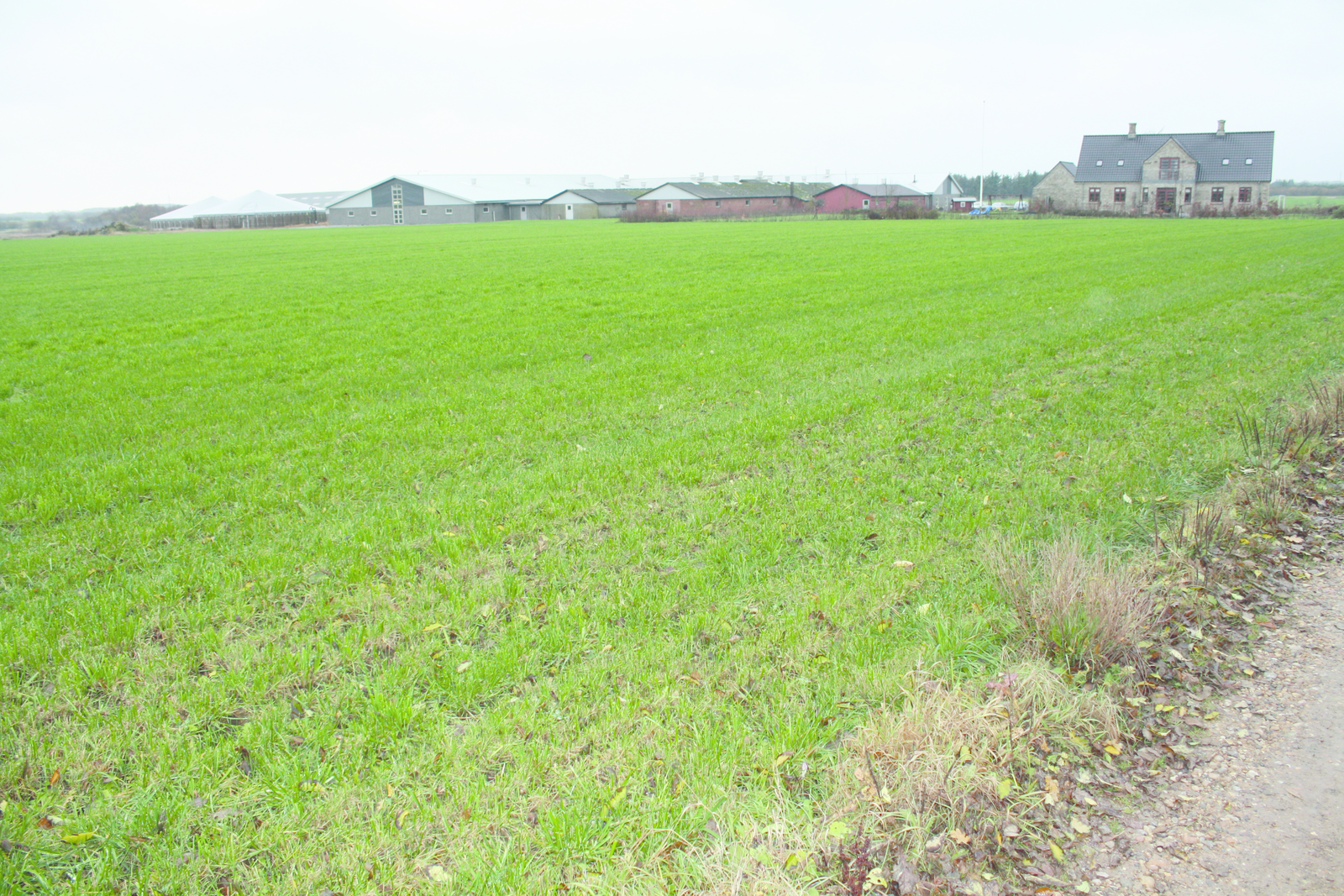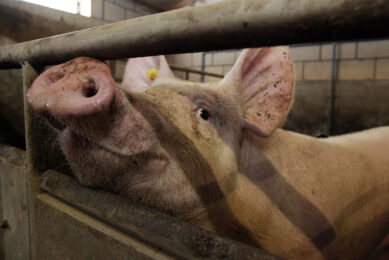Slow feed helps to prevent bloating in sows

Nowadays, Danish farm owner Kim Heiselberg needs tiptoe through his breeding department. No nervousness, no scary sows – just peace and quiet amongst the sows and piglets and he likes to keep it that way. His secret? He implemented dietary improvements to prevent bloating in sows.
By Vincent ter Beek
Doors go open, the group of visitors step in, prepared to suddenly hear the well-known sound of large animals suddenly standing up, loud oinking and the nervous cracking against the metal crate. On this day, however, things are different as no sound can be heard. One would assume this farrowing room is empty – until the lights go on and sixteen peacefully lying pink bodies appear behind the grey crate walls.
The location is the breeding section of Hedegård Farms, near the village of Tarm, on the west coast of Danish Jutland. Owner Kim Heiselberg, proudly shows the quiet farrowing rooms and says that the peaceful situation has not always existed. A sow diet change, carried out in March 2009, made a large difference, he says. Most of his problems appeared to have been related to feed-related stress problems in gestating sows.

Kim Heiselberg: “What we saw was sows being as round as a ball, clearly having stomach pain after feeding.”
Dietary problems existing in gestating sows are not uncommon in Denmark, where an average production of 28-29 pigs/sow/year is currently being reached. Demands on the sow’s prolificacy constantly increase. Sows have to eat more to be able to cope with the increased litter sizes and demand for milk. Hence, it is not difficult to imagine that especially in the peripartal phase, stress can occur. Many factors coincide here: litters taking more room; the move from a gestation building to farrowing rooms; feed changes; hormonal changes and a reduction in feed and water intake.
Practical example
Until last year, Heiselberg fed his more than 700 sows a dry pelleted feed menu, consisting mainly of barley and wheat, supplemented by oats, soy, vitamins and amino acids. His sows were fed three times a day. The menu, however, was not always a great success as he faced a problem of ‘bloating’ in sows.
The animals were suffering from digestive problems, which was characterised by sows generally not looking very well, he says.
“If a sow eats her feed well, and it is digested correctly, we see her for instance lying down to give milk – then stand up again to eat the rest. What we saw, however, was sows being as round as a ball, clearly having stomach pain after feeding. They would lie on their belly, protecting it, not giving any milk. Sometimes, when we noted this at 6pm, they could be dead by midnight.”

Improving digestion in the stomach
Feed company Vestjyllands Andel (VA), located in Ringkøbing, Denmark, is part of the Danish cooperative DLA Agro, and emerged five years ago as the result of takeovers. VA has three production locations in the West Jutland area, in total employing 110 people and producing 300,000 tonnes of feed/year.
VA mainly produces feed for the whole pig range from sows to finishers; the VA cooperative aims to produce high quality feed, in 150 different recipes. One of the recipes provided for farmers includes the use of rolled barley for about 15-20%. The principle was introduced by VA about 15 years ago and is provided by most Danish feed millers nowadays.
Torben Jensen, product manager at VA, explains that barley is rolled until it forms flat particles. This can be included in the feed mix after the rest has been heated and pelleted. Adding rolled grains leads to more feed surface becoming available for pig stomachs, Jensen explains, meaning that the process of digestion takes longer. In pig behaviour this translates in earlier saturation, he says. Ideally, feed intake will be the same but feed consumption is more evenly balanced through the day, which is beneficial for stomach health for both sows and finishers as less ulcers appear.
Vestjyllands Andel claims this way E.coli and salmonella can be controlled. As for the salmonella, as early as 1996, a group of Danish researchers (Wingstrand and others; IPVS Congress 1996, Bologna) investigated the role of coarse ground feed in controlling salmonella in finishers.
In the paper, the authors hypothesised “this partly to be due to […] stabilisation of the competitive gastrointestinal microflora from coarse grinding of home mixed feed.” Their test showed that a diet containing coarse ground wheat and pelleted concentrate, in combination with water in which formic acid was added, had a strong positive effect on salmonella seropositivity at slaughter. VA also promotes slow and more regular feed intake by adding dried alfalfa to diets. This leads to a non-pelleted, structured diet.
Sows suffering from Mastitis, Metritis, Agalactia (MMA) after farrowing and mortality figures leading up to 12.8% – ‘much too high’ – made Heiselberg decide that something needed to be done. But what? Seeing that he wanted to do home-mixing in the future, he decided go for a try-out and ordered ‘home-mixed style’ feed from the nearby feed manufacturer Vestjyllands Andel (VA) – a novel concept in which most pelleting has been skipped and feed has been mixed as if it was home-mixed. “Apart from the addition of a bit of maize to the sows in farrowing, we did not change much to the ingredients of the feed. It was mainly the way it was presented,” Heiselberg explains.

After being fed home-mixed style feed, lactating sows are lying on their sides again, indicating well-being.
Barley now became rolled barley (See Box “Improving digestion in the stomach“). As a feed additive, a live yeast product (200 g/tonne) was added (See Box “Improving the sow’s gut functioning“). That was March 2009. Now, approximately one year later, he concludes that he is very happy with the outcome. Sows have looked more at ease ever since. Lactating sows are lying on their sides again instead of on their stomach, indicating well-being. Mortality had already come down to 8% by the end of September 2009. The sows weigh about 15-20 kg more by the end of the lactating period, as their feed intake is better. Heiselberg has moved on to use the same concept for his weaned piglets now, from 7-30 kg. Post-mortem section often showed that he had a problem of Actinobacillus pleuropneumoniae and Mycoplasma. Since the weaners have received the home-mixed style feed, post-weaning mortality figures changed – up to 30% less, Heiselberg says.
Farm data: Hedegård Farms
Hedegård Farms, near Tarm, Jutland, Denmark, was established in 2003 and is a rapidly growing breeding farm. Having started off with 160 sows, the farm now has 730 sows and hopes to expand to 1,400 sows in 2010. The farm sells its piglets to finishing farms; in addition, the farm has a 4,000 pig finishing facility for unsold weaners. In total, with two additional employees from Poland, Hedegård Farms produces 21,700 piglets/year. Approximately 17,000 weaners are sold per year. Owner Kim Heiselberg reaches very reasonable results, having an average of 14.4 live born piglets per sow, leading up to over 31 piglets/sow/year.
When new high health gilts (Landrace x Yorkshire) are brought in, five times per year, they are vaccinated for parvovirus (PPV), E.coli and Mycoplasma. Heiselberg keeps his dry sows in free access stalls.
Wrapping up, he says, “We do not know if it was the structure of the new feed and/or the addition of the yeast product. “Anyway, the new home mixing product seems to have boosted the sow performance, as they need to eat!”
For more pictures of the Vestjyllands Andel plant
[Source: AllAboutFeed magazine Vol 1 nr 8, 2010]
Join 26,000+ subscribers
Subscribe to our newsletter to stay updated about all the need-to-know content in the feed sector, three times a week. Beheer
Beheer









 WP Admin
WP Admin  Bewerk bericht
Bewerk bericht